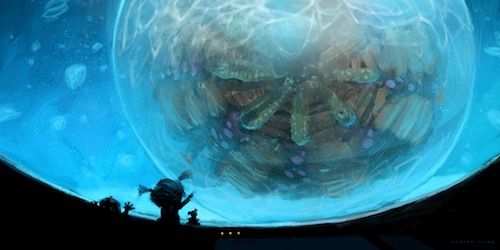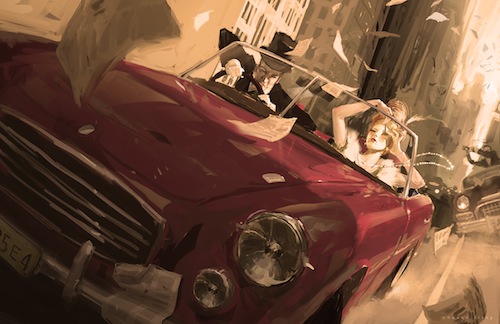
Entertainment Design alum Edmund Liang
Edmund Liang is a multidisciplinary artist specializing in transmedia narratives and multi-sensory spatial experiences. Last fall, Liang was named one of Complex Art+Design’s 25 People Shaping the Future of Design and his projects—video games, interactive media, film and animation, motion graphics, photography—are as eclectic as his client list, which includes the Famous Group, Jim Henson Company, Dreamworks, Psyop, Imaginary Forces and Logan.tv.
A self-described “provocateur” in his field, Liang was once an “art kid” in high school who had no idea that there was a world of design. “I didn’t know that the keyboard in front of me was designed,” he recalled. “I didn’t know that the video games I was playing had people behind them.”
By the time it came time to consider colleges, Liang was first attracted to Art Center’s Illustration program and touring the campus prior to enrolling, he said, “I got the impression that it was a very rigorous and serious school. That’s what I wanted.”
Art Center turned out to be a “gold mine,” said Liang, who transferred to Entertainment Design in his third term. Acting on his conviction that he would “learn exponentially more if I pursued things that I also really liked,” Liang jumped into graphics and motion graphics classes, product design, environmental design, interactive, fashion photography and more. If students at Art Center stay only within the boundaries of their specific major, he observed, “you’re totally not taking advantage of the school, and its wide scope of talent and really powerful facility and faculty.”
“Entertainment design is more than you think it is,” Liang said. “It is whatever you want it to be. There are design opportunities all around you,” he added, noting that many of his projects spring from the question, “What if?”
“What if the airlines didn’t have to be the way they are? This chair that I’m sitting on, this table in front of me, this meal that I’m getting,” said Liang, who was preparing dinner for friends as he spoke by phone, “are there problems with them? Can things be better? Can video games be turned in a way where certain audiences can be more involved? Can a place blur the boundaries between audience and performers, and how?”
The next step, Liang observed, “is just to do it,” a message that he internalized during his undergraduate studies and honors term, he said. “My lesson at Art Center was, ‘you have these ideas and you have these skill sets, so just do it.’”
Liang describes his multidisciplinary, multiplatform work in terms of immersive experiences. “We create a brand as a logo, then we take that into the business card, which is a physical object. Then we take that into the web, which is a digital network that everybody can access, so it’s a completely different platform. Maybe it could be a game, so it’s a different type of interaction. But then it can also be a spatial installation, or an architectural space. It’s taking forms in all these different ways: from a business card, to a poster, to a mailing envelope, to a website, an iPad app, an installation, a space.”

Artwork by Edmund Liang
Designing just one aspect of that branding, Liang said, would be like going to a nice restaurant and eating a great meal, “but the dishes it was presented on don’t match, or the menu was ugly or the lighting was wrong. The experience overall was not harmonious.”
His work encompasses print work, projects for motion graphics design studios–where “you never know what they’re going to throw at you,” Liang said–interactive plays, fashion and non-documentary photography, and photo documentation of his own life, “in a way where it’s a complete exaggeration of who I am.”
Liang is intrigued, too, by design possibilities inherent in architectural firms “that are a little bit more daring,” in theatrical enterprises like Cirque de Soleil, “where they create a new show for a certain type of impact or exhibition design”; and in his comprehensive, speculative “fantasy projects” that come from Liang’s own “experiences in the world, the problems that I see and my wishes.”
One of these, “FabAir,” is a concept airline that challenges “what a commercial flight could be,” Liang said, inspired by “a horrible 30 hour flight from here to D.C., where I was stuck in Dallas for a long, long time.” He reconceived the interiors of a Boeing 787, an airline gateway and an airport terminal, using orthographic drawings and 3D models and writing an 80-page discussion about the concept, “to provoke the question of, are airlines the best they can be? And of course the answer is no,” he said.
The result: “It’s pretty much an airline for extroverts,” Liang said. “It’s just, how can we enjoy our time on the plane, and take advantage of passenger diversity? We’re stuck in a tube in the sky with all these wonderful people, why not engage with them?”
One of his professors at Art Center, Liang said, gave him a quote (attributed to Wayne W. Dyer) that he lives by: “‘If you change the way you look at things, the things you look at will change.’ I would say that is one of the longest running quotes in my head,” Liang said. “That has kept me doing the things that I do every day.”
Lynne Heffley is a Los Angeles-based freelance journalist who writes about the arts.










Originally inside World at War version players were four unnamed marines fighting over hoard, making
sense. s fiberglass body was built from your genuine fiberglass coffin “Korky” purchased
from the funeral home in North Hollywood. As you search the graveyard, you’ll find money or food items within the graves, and random zombies (or zombie
hunters) attack you, which is how you gain heads. The question is
just not if Frankenstein is really a zombie or possibly not, instead,
is obviously Frankenstein the daddy of most Zombies.
There are a few informal groups within the game, but there isn’t any formalized version of mobs
or hordes. The only small complaint is that there are no
save system. These three games have impressed and entertained players owned by different age brackets and different nationalities.